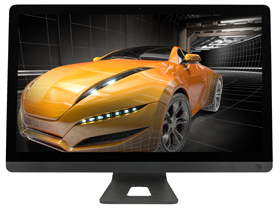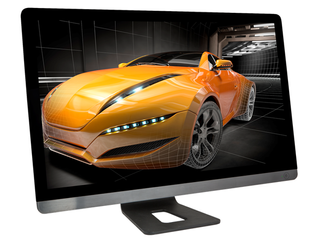Planar 27" QHD Monitor Review: Clarity Like We've Never Seen
Planar sent over its newest QHD screen, the 27" PXL2790MW. This is the sharpest display we’ve ever seen, and one of the most accurate. With high-end styling and a 2560x1440 native resolution, it introduces a sense of luxury to the business class.

Planar PXL2790MW: Clarity, Performance, And Accuracy In QHD
When we review business-class monitors at Tom’s Hardware, it's understood that they're probably not an enthusiast's first choice for a high-performance rig. But the reality is that monitors branded as gaming products aren't much different than less heavily marketed models. In fact, we really only see high refresh rates as the differentiator creating a specific enthusiast focus. All other performance factors start on the same plane, regardless of whether a monitor is aimed at business users or entertainment seekers.
To that end, we always try to look for aspects of performance that appeal to our audience of enthusiasts. And the tests we perform are all centered on one thing: image quality. We’ve established that the best-looking displays will have a wide dynamic range, accurate color, correct grayscale, and a flat-tracking gamma of 2.2. We also look at response time and input lag, as well as screen uniformity and viewing angles. But there’s one component we haven’t addressed before now, and that's clarity. The main reason, of course, is that we didn't have a scientific and repeatable way to measure it. Clarity is largely a matter of opinion, and that is something we try to avoid when we make our recommendations.

That changed when we received Planar’s PXL2790MW. Often times, we run our benchmark suite before viewing actual content. The test patterns we use lack too much detail to adequately differentiate the clarity of various displays. When we received this display, however, we were so taken by its styling that we put it on a desktop right away and were immediately struck by its razor-sharp image.
You've seen Tom's Hardware review a good number of QHD screens this year, and you already know that it's our new standard for desktop displays. The extra screen real estate afforded by a pixel density of nearly 109 ppi makes most tasks much easier. But we've also noted that most monitors need some form of scaling to make text easier to read. Windows 7 does a very poor job of this. Even though fonts are enlarged, character edges get so distorted that the experience is akin to looking through smudged spectacles. Finally, we resorted to using the scaling built into most applications, which almost always offers better performance. With the new PXL2790MW, we quickly discovered there was no need for scaling in any program. The image is so clear that even the smallest text is fully legible.
We had an educational conversation with one of Planar’s product managers about the PXL2790MW. He spoke to us about the company's research, which of course indicated that most computer users want a high level of luxury and quality in a display. Once someone works with a large, high-pixel density monitor, they don’t want to go back to a lower-res 21-inch screen. We've been saying that for years!
While QHD screens are becoming more common, their prices still tend to hover above $600, with gray-market Korean monitors being the exception. We tested Auria's EQ276W and found it to be a decent-performing display. But if you want high-end build quality and reliable factory support, you have to look at more mainstream brands.
| Brand | Planar |
|---|---|
| Model | PXL2790MW |
| MSRP | $700 |
| Panel Type | AH-IPS |
| Backlight | W-LED |
| Screen Size | 27" |
| Max Resolution | 2560x1440 |
| Max Refresh Rate | 60 Hz |
| Aspect Ratio | 16:9 |
| Response Time (GTG) | 6.5 ms |
| Brightness | 440 cd/m2 |
| Speakers | 2 x 2 W |
| VGA | 1 |
| DVI | 1 |
| DisplayPort | 1 |
| HDMI | 1 |
| Headphone | 1 |
| USB | - |
| Dimensions w/baseW x H x D | 25.6 x 18.7 x 7.9 in650 x 475 x 201 mm |
| Panel Thickness | 1.7 in / 45 mm |
| Warranty | Three years |
Planar’s New Technology
How does Planar achieve such a sharp image? There’s nothing in the company's specs able to answer this, except maybe the high brightness. But that’s not it. The company did something unique with this new screen called layer-bonding; and it’s something we’ve never seen before.
Stay on the Cutting Edge
Join the experts who read Tom's Hardware for the inside track on enthusiast PC tech news — and have for over 25 years. We'll send breaking news and in-depth reviews of CPUs, GPUs, AI, maker hardware and more straight to your inbox.
Although Planar is using an LG AH-IPS panel in the PXL2790MW, the way it’s integrated with the front protective layer is unique. In most displays, there is a small air gap between this layer and the LCD panel. Planar is bonding them together, eliminating the gap. The result is significantly greater clarity. And this isn't a gimmick; we noticed it as soon as we turned the monitor on. Not only is it exceptionally bright, but the sharpness of even the tiniest text is greater than displays with a typical anti-glare screen coating.
Current page: Planar PXL2790MW: Clarity, Performance, And Accuracy In QHD
Next Page Packaging, Physical Layout, And Accessories
Christian Eberle is a Contributing Editor for Tom's Hardware US. He's a veteran reviewer of A/V equipment, specializing in monitors. Christian began his obsession with tech when he built his first PC in 1991, a 286 running DOS 3.0 at a blazing 12MHz. In 2006, he undertook training from the Imaging Science Foundation in video calibration and testing and thus started a passion for precise imaging that persists to this day. He is also a professional musician with a degree from the New England Conservatory as a classical bassoonist which he used to good effect as a performer with the West Point Army Band from 1987 to 2013. He enjoys watching movies and listening to high-end audio in his custom-built home theater and can be seen riding trails near his home on a race-ready ICE VTX recumbent trike. Christian enjoys the endless summer in Florida where he lives with his wife and Chihuahua and plays with orchestras around the state.
-
stoogie 16.2ms SMTT reviewed catleap or crossovers from greensum/korea LG S-IPS have been out for well over 2 years now at a $300 or less starting price. Get with the times toms.Reply -
Bondfc11 I agree with stoogie - also Toms needs to get an Overlord tempest and take a look at a real gaming 1440 panel that can do up to 120hz refresh rates. This screen isn't that special and the housing has been around in other variants for a year now as well.Reply -
tpi2007 445 cd/m2 of luminance as maximum and 174.7655 cd/m2 as minimum ? Why do monitor manufacturers insist on delivering brighter and brighter monitors ? People don't use them like they are on display in a very well lit showroom, if you want to use one of these at home with just an indirect light source on the wall for some gaming at night, you're out of luck, this doesn't even reach the industry standard of 120 cd/m2 as adequate regular brightness, let alone the 50 cd/m2 that Tom's and many others consider an acceptable minimum to have in a darker room.Reply
-
s3anister Reply12033250 said:no award?
What do you seriously think that another 27" 2560x1440 60Hz monitor that is already in class with a dozen other models identical to it, deserves an award? -
DarkSable Looks exactly like the "new" QHD Iiyama. Doesn't perform well. Costs a lot. What's the advantage, again?Reply
As for those overlord monitors, I wasn't impressed by them, mostly because I had it sitting next to a lightboost 2 120hz TN panel. Yes, the overclocked IPS panel has better colour (though that's largely negated by using it on minimal brightness in a dark room, like we've already been talking about), and it's certainly pretty and gives a lot of screen real estate... but it can't compare to a real 120Hz monitor, especially not one with a strobing backlight. -
WyomingKnott "With the new PXL2790MW, we quickly discovered there was no need for scaling in any program. The image is so clear that even the smallest text is fully legible." Technically admirable, but not enough for people like me with middle-aged eyes. The more pixels per inch, the happier my eyes are, but they still want decent-sized fonts.Reply
Now this sort of monitor clarity plus an OS that supports decent enlarged fonts would be really nice. Apps that scale well over a range of sizes would be even nicer. A 1000 pixel wide frame may be good for some people no matter how small it is; others of us would like at least a certain number of inches. Support all of us.
(Yes, I know that this isn't the monitor's fault. It's a poor convention in many parts of the software industry.) -
warezme I have never had a major problem with text clarity with pretty much any LCD since the first thing I make sure to do is set the panel or monitor to native resolution hardware scaling and turn off all windows text or font smoothing and windows set to the same monitor native resolution. I haven't seen one of these 2560 screens in person but I have experienced the default font issue that happens when you try and let windows smooth or scale. I don't like monitors with radiused corners because that makes the bezels even thicker then they need to be. I also don't like the way most monitor manufacturer try to hide the input plugs by making them inset and pointing down. It is a pain to try to plug or unplug anything when you can't see the plug without laying the monitor on its side. Also it makes no use to label the inputs if they are inset dark on dark. Make the text white.Reply -
-Fran- This deserves a "meh" award at most.Reply
QHD is not ready for gaming prime time yet, sorry folks.
Cheers!
Most Popular

